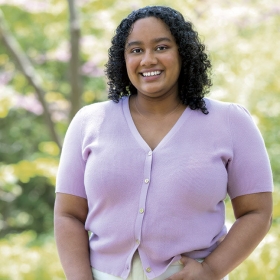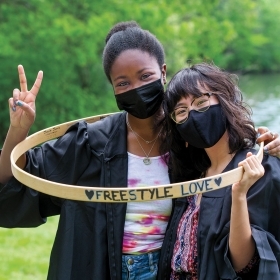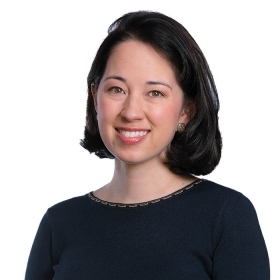Sophie Hurwitz ’21 and Madison Ann Lee ’21
Despite some big changes during the pandemic, the role of The Wellesley News hasn’t changed—to amplify student voices, serve as a record of life on campus and issues students care about, and provide practical training in journalistic writing.

Photo by Lisa Abitbol
Sophie Hurwitz ’21 (above right) and Madison Ann Lee ’21 (above left) had a highly untraditional transition to becoming co-editors in chief of The Wellesley News. When the COVID-19 pandemic hit in March 2020, they both were abroad—Hurwitz in Buenos Aires and Lee in Córdoba, Spain. After the hectic rush of returning to the States and recalibrating their plans, “We were suddenly like, nobody else is applying to be editors in chief of the newspaper. We’ve got to be editors in chief,” Hurwitz says. “We did not get much of a training or onboarding … just by virtue of, you know, the world ended a little bit. And so it’s been a lot of learning on our feet and trying to play catch-up and just keep this thing afloat.”
Much of what they learned was how to adapt to the pandemic. “For over 100 years, the News has been more or less a weekly publication. This year, while we do have an email newsletter, it is primarily just a website, and that means that things aren’t published on as regular a schedule anymore, which can be a good thing,” says Lee. “I think we’ve improved our breaking news coverage a lot because of that, and finally walked into the modern era in that sense.”
However, they agree that the role of the News hasn’t changed—to amplify student voices, serve as a record of life on campus and issues students care about, and provide practical training in journalistic writing. “News media in general has always been an exclusive space, and The Wellesley News is very nonexclusive. We encourage everyone to write,” says Lee.
One pandemic innovation was the addition of section-specific Zoom meetings, where editors were able to give writers more in-depth training. Lee, who came up as an editor through the arts section, says that because of these additional meetings, “I think writers are so much more confident now that they get to talk to somebody about how they’re going to write a piece.”
Much of the paper’s coverage during the 2020–21 academic year was related to COVID—the effects of safety measures on students’ mental health, athletics during the pandemic, how societies modified “tea-ing” during the time of social distancing and remote learning, and more.
One of Hurwitz’s favorite stories was by Ann Zhao ’24 about how the Wellesley College Shotokan Karate Club was able not only to keep its community afloat but to grow it. “That’s been the throughline in a lot of the stories that I’ve particularly loved, how people have been finding ways to keep their community together,” they say. “It’s true of the story that we did really early in the year about Wellesley alums helping each other out and current students helping each other out during the California wildfires. It’s true of the story we ran on groups of students living together off campus.”
Lee thinks an important story this year was an opinion piece by Tiana Brote ’21 about discrimination faced by dining hall workers and her concerns about AVI, the College’s food services vendor, including its relationship with private prisons. “I think there are threads of that [discussion] that have bled into other conversations about how we interact with admin as students, and as a collective body,” Lee says. At commencement, President Johnson announced that with encouragement from the College, AVI had divested from prison food systems.
Both editors find fulfillment in the community they built through the News, too. Hurwitz mentions a first-year writer who hadn’t been on campus all year. “It’s been nice being able to use the News as a way to connect people to campus,” they say. And the co-editors are thankful for all the work the writers put into the paper. “It [was] so hard to put effort into anything this year, given the world falling apart around us. So the fact that the students that we get to work with have been able to just put so much into this student newspaper … that’s amazing,” Hurwitz says.


